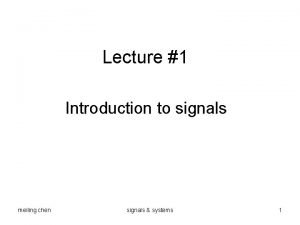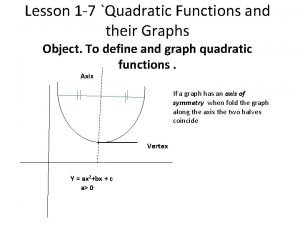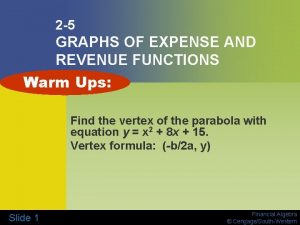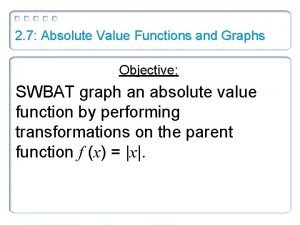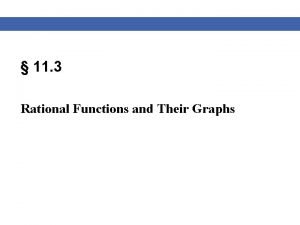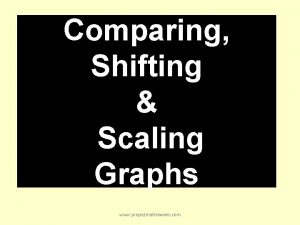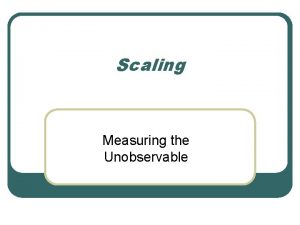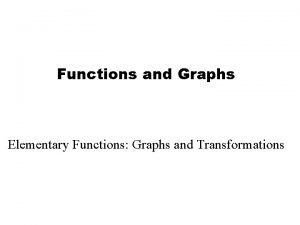Shifting and Scaling Graphs of Functions All slides























- Slides: 23

Shifting and Scaling Graphs of Functions All slides in this presentations are based on the book Functions, Data and Models, S. P. Gordon and F. S Gordon ISBN 978 -0 -88385 -767 -0

Building New Functions From Old Four Ways to build new functions from old: 1. By adding or subtracting a constant from the function y 2. By adding or subtracting a constant from the independent variable x 3. By multiplying the function y by a constant 4. By multiplying the independent variable x by a constant. p. 2

Example of Vertical Shifting Consider y = f(x) = x 2 and four related quadratic functions Look at the graphs of all these functions in figure 7. 1

Vertical Shifting Summary

Example the Zigzag Function The function f(x) = zig (x) is shown below in figure 7. 2 Table of values of the graph p. 5

Example the Zigzag Function Continued Let’s examine y= zig (x) + 2 shown below in figure 7. 3 All values of y have increased by 2 in the new function y = zig(x)+2 p. 6

Example Impact on f(x) when Adding/Subtracting a Constant to X • What is the effect of the constant in each of these functions? (see figure 7. 4) p. 7

Definition of Horizontal Shift p. 8

Example of Horizontal Shift Solution See Figure 7. 5 The graph y = zig(x + 2) is simply shifted 2 units to the left of y = zig( x ). (Notice for y = zig(x + 2) we start the graph at x = -2 and end the graph at x = 6) The graph y = zig(x - 2) is simply shifted 2 units to the right of y = zig( x ). (Notice for y = zig(x - 2) we start the graph at x = 2 and end the graph at x = 10) p. 9

Summary of Horizontal and Vertical Shifting 1. When replacing x by x – a, when a > 0, we are changing x and produce a horizontal shift to the right of a units 2. When replacing x by x + a, when a > 0, we are changing x and produce a horizontal shift to the left of a units 3. When replacing y by y – b, when b > 0, which is equivalent to replacing f(x) by f(x) – b, we are changing y and produce a vertical shift above of b units 4. When replacing y by y + b, when b > 0, which is equivalent to replacing f(x) by f(x) + b, we are changing y and produce a vertical shift below of b units p. 10

Completing the Square 1. If a quadratic equation does not factor readily, then we can solve it using the technique of completing the square. p. 11

Combined Horizontal and Vertical Shift • p. 12

Example Continued

Vertical Stretching Example Sketch the graph of Y = zig (x) and y = 3·zig(x) Let’s look at the table of values below and the graph of both functions to the right in Figure 7. 7 Note: Every value of y in the graph y = 3 zig(x) increases by a factor of 3 compared to the graph y = zig (3)

Vertical Shrinking

Summary Vertical Stretching and Shrinking p. 16

Negative Factor Stretching Example p. 17

Vertical Stretching and Shrinking Summary p. 18

Horizontal Shrinking Both functions have two turning points with the exact same y values and both functions pass through the origin. The curve y = f(2 x) traces out identical vertical values as f(x), but it does so twice as fast in either direction starting at x = 0. p. 19

Horizontal Stretching p. 20

Summary Horizontal Stretching and Shrinking p. 21

Negative Factor for Horizontal Shrinking p. 22

Example p. 23
 Shifting and scaling functions
Shifting and scaling functions Shifting and scaling functions
Shifting and scaling functions Precedence rule in signals and systems
Precedence rule in signals and systems Shifting reflecting and stretching graphs
Shifting reflecting and stretching graphs 5-3 practice polynomial functions
5-3 practice polynomial functions Graph shifting
Graph shifting Good state and bad state graphs
Good state and bad state graphs Graphs that enlighten and graphs that deceive
Graphs that enlighten and graphs that deceive Graphs that compare distance and time are called
Graphs that compare distance and time are called A small child slides down the four frictionless slides
A small child slides down the four frictionless slides A small child slides down the four frictionless slides
A small child slides down the four frictionless slides Name 3 points
Name 3 points Horizontal asymptote rules
Horizontal asymptote rules Quadratic functions and their graphs
Quadratic functions and their graphs Lesson 1-2 analyzing graphs of functions and relations
Lesson 1-2 analyzing graphs of functions and relations Removable and nonremovable discontinuity
Removable and nonremovable discontinuity Algebra graphs and functions
Algebra graphs and functions Revenue function graph
Revenue function graph 1-2 analyzing graphs of functions and relations
1-2 analyzing graphs of functions and relations Chapter 1 functions and their graphs
Chapter 1 functions and their graphs Analyzing functions and graphs
Analyzing functions and graphs 2-7 absolute value functions and graphs
2-7 absolute value functions and graphs Rational functions and their graphs
Rational functions and their graphs Common functions and their graphs
Common functions and their graphs


